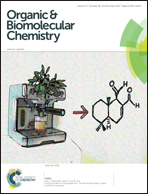Targeting tumor hypoxia: a third generation 2-nitroimidazole-indocyanine dye-conjugate with improved fluorescent yield†
Abstract
Tumor hypoxia is associated with the rapid proliferation and growth of malignant tumors, and the ability to detect tumor hypoxia is important for predicting tumor response to anti-cancer treatments. We have developed a class of dye-conjugates that are related to indocyanine green (ICG, 1) to target tumor hypoxia, based on in vivo infrared fluorescence imaging using nitroimidazole moieties linked to indocyanine fluorescent dyes. We previously reported that linking 2-nitroimidazole to an indocyanine dicarboxylic acid dye derivative (2) using an ethanolamine linker (ethanolamine-2-nitroimidazole-ICG, 3), led to a dye-conjugate that gave promising results for targeting cancer hypoxia in vivo. Structural modification of the dye conjugate replaced the ethanolamine unit with a piperazineacetyl unit and led a second generation dye conjugate, piperzine-2-nitroimidazole-ICG (4). This second generation dye-conjugate showed improved targeting of tumor hypoxia when compared with 3. Based on the hypothesis that molecules with more planar and rigid structures have a higher fluorescence yield, as they could release less absorbed energy through molecular vibration or collision, we have developed a new 2-nitroimidazole ICG conjugate, 12, with two carbon atoms less in the polyene linker. Dye-conjugate 12 was prepared from our new dye (8), and coupled to 2-nitroimidazole using a piperazine linker to produce this third-generation dye-conjugate. Spectral measurements showed that the absorption/emission wavelengths of 657/670 were shifted ∼100 nm from the second-generation hypoxia dye of 755/780 nm. Its fluorescence quantum yield was measured to be 0.467, which is about 5 times higher than that of 4 (0.083). In vivo experiments were conducted with balb/c mice and 12 showed more than twice the average in vivo fluorescence intensity in the tumor beyond two hours post retro-orbital injection as compared with 4. These initial results suggest that 12 may significantly improve in vivo tumor hypoxia targeting.


 Please wait while we load your content...
Please wait while we load your content...